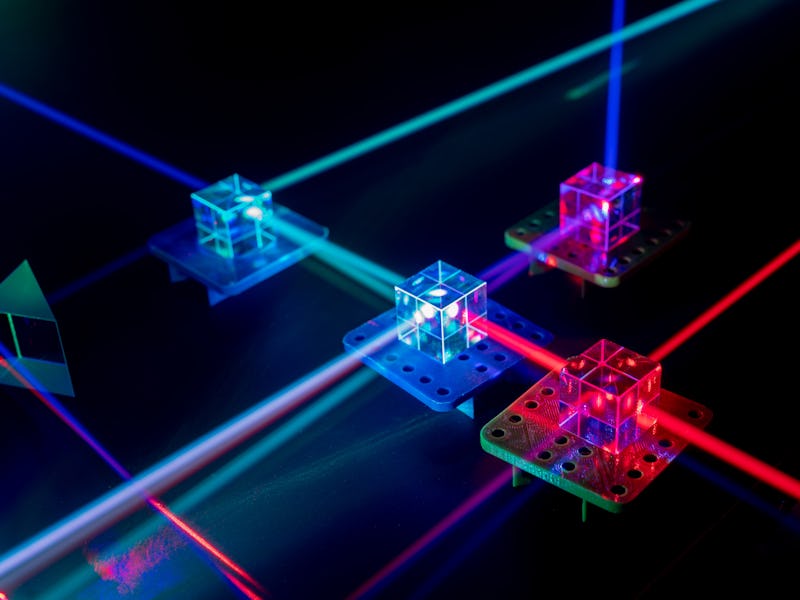Photonic computers could solve a classic problem that stumps your laptop — study
Quantum computers might want to watch their backs.

In recent years, the world of computing has been going through some growing pains. Futurists and technologists are openly wondering about the fate of classical computers which run on CPUs and GPUs. But replacements like quantum and molecular computers are just over the horizon.
Now, a new study says that an entirely different computing beast may take the lead.
Enter photonic computing.
On its face, photonic computing sounds a little like an oxymoron. After all, how can the same light we use to light our houses be used to solve complex computation equations? It comes down to the different flavors of light and the unique way they work together to move information.
A new study published Friday in the journal Science Advances looks at how light can be used to solve an exponentially difficult computational problem called the subset sum problem (SSP.) In a nutshell, this problem takes a set of numbers (like a list) that can contain any amount of numbers, and asks a computer to determine whether there is a subset of the original set (a small part of the larger list) that when summed is equal to a given target value. For example, if your given list was {3, 34, 4, 12, 5, 2} with a target sum of nine, then the subset to satisfy that condition would be (4,5.)
While this problem might sound pretty doable, its complexity actually grows exponentially as the amount of numbers in the list grows, and is considered nearly impossible to solve in reality using a classical computer for large list sizes.
In order to tackle this problem using photons, the team used a femtosecond laser to etch into glass the SSP problem as a network of 3D pathways to create a processing unit for the photons to move along. The photons, in this case, can be compared to an electrical current in a classical computer. To begin the computation, an 810nm laser injects photons into the chip. Once inside the network, the photons begin trying different combinations of sums in parallel -- basically, all at once. Zooming in and out of the processing unit's ports like bees, the movement of these photons (horizontal or vertical) denotes whether an input is being added to the total sum or ignored.
Researchers injected a laser into etched pathways on a glass processing unit in order to solve a complex math problem that classical computers struggle with.
Using an experimental set of values the team saw that the numbers identified as part of the sum by the photon processor matched what would be expected theoretically, meaning the photon processor had successfully solved that iteration of the problem.
While being able to solve a small subset of this problem isn't exactly novel itself, the researchers write that what's most effective about this approach is that it is easily scalable in ways that other computational methods aren't. While quantum computers deal with interference and molecular and electronic computers can be slow as a result of heat, photonic computers can make calculations in a single nanosecond, and can operate in extremely limited space without loss of efficiency, making them great candidates for scaling.
Coauthor on the paper and Distinguished Researcher in the Department of Physics and Astronomy at Shanghai Jiao Tong University (SJTU), Xianmin Jin, tells Inverse that photon computers won't totally overshadow quantum computers in the future, but that each will play important roles in the evolution of computing.
"We are not sure which one will be more useful or powerful in the future, but we do believe photonic computer has its own unique feature and advantages for some scenarios, and will definitely play an important role in extending the computing power for humankind," says Jin.
The authors also write that in being able to successfully solve iterations of the SSP problem, the photonic computer demonstrated that they'll be capable of solving other similar, scalable problems, such as resource allocation of things like computer bandwidth or crop yields. Jin also tells Inverse that photon computers could also be used in the future as cloud servers and even integrated into certain "hybrid computers" as a supercharged processing unit.
But while such a computer isn't coming to a neighborhood near you anytime soon, researchers say it could compete with quantum computers for supremacy over classical computers. Just as Google has recently demonstrated quantum supremacy by being able to solve a (very narrow) computational problem better than a classical computer, the researchers say that solving an SSP problem could be the benchmark for so-called photonic supremacy, the moment when a photon computer is able to out-solve a classical one. Such supremacy, for either computer model, is more about accolades than actual supremacy in the computing space at this point, but it does demonstrate how these computers could one day be used to crunch data classical computers can't dream of.
Abstract: The subset sum problem (SSP) is a typical nondeterministic-polynomial-time (NP)–complete problem that is hard to solve efficiently in time with conventional computers. Photons have the unique features of high propagation speed, strong robustness, and low detectable energy level and therefore can be promising candidates to meet the challenge. Here, we present a scalable chip built-in photonic computer to efficiently solve the SSP. We map the problem into a three-dimensional waveguide network through a femtosecond laser direct writing technique. We show that the photons sufficiently dissipate into the networks and search for solutions in parallel. In the case of successive primes, our approach exhibits a dominant superiority in time consumption even compared with supercomputers. Our results confirm the ability of light to realize computations intractable for conventional computers, and suggest the SSP as a good benchmarking platform for the race between photonic and conventional computers on the way toward “photonic supremacy.”